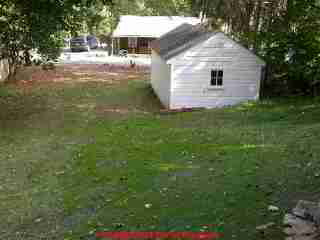 Guide to Final Site Work after Sewer Line Replacement
Guide to Final Site Work after Sewer Line Replacement
- POST a QUESTION or COMMENT about site restoration and seeding after septic or sewer line replacement jobs
This article describes the final steps in site restoration work after a building sewer pipe or "drain line" is replaced.
We present an actual case study, illustrated with photos of each step in the diagnosis and replacement of a blocked sewer line.
The waste line in this case was found to be blocked, damaged, old, and needing replacement in the course of an attempt to clear a blocked drain between the house and septic tank. Technical reviewers are welcome and are listed at "References."
InspectAPedia tolerates no conflicts of interest. We have no relationship with advertisers, products, or services discussed at this website.
Final seeding and soil restoration after sewer line replacement
The contractor agreed to remove the old concrete sidewalk that had been a long-standing slip-trip hazard down this hill. Having them cart off those chunks of concrete was a bonus to the job.
We also asked the contractor to leave the final fill mounded slightly "high" over the areas of sewer line trench excavation,so that as the backfill settled we wouldn't see a ditch running down the property.
As soon as the contractors and their backhoe left the site, we scouted up an iron rake, picked out the big rocks and scraps of
old ORANGEBURG PIPE or clay pipe that had been left, and removed the large rocks.
We put down a mix of fast-growing seed as well as permanent grass seed and kept the site watered. If we'd been in a rainy season we'd have also needed to put down straw or fabric to keep our seed from washing off of the hill.
In less than two weeks our muddy work site was beginning to look like a grassy lawn again. Having used durable, smooth-interior, hubless plastic drain line piping and having made the connections tight we expect the new waste line between this house and its septic tank to remain intact for many years.
Having tight leak proof drain lines not only is required for sanitation, it also avoids attracting invading tree roots.
...
Continue reading at SEWER / SEPTIC LINES at STEEP SITES or select a topic from the closely-related articles below, or see the complete ARTICLE INDEX.
Or see these
Recommended Articles
- SEWER LINE REPLACEMENT
- DIAGNOSE a BLOCKED DRAIN
- WHEN to CALL a PLUMBER
- FIND the MAIN BUILDING DRAIN
- USE a POWER SNAKE to CLEAR a BLOCKED DRAIN
- FIND DISTANCE to DRAIN BLOCKAGE
- DETERMINE NEED for DRAIN LINE REPLACEMENT
- REPLACE SEWER LINE, STEP BY STEP
- MAKE OTHER SEPTIC REPAIRS
- INSTALLING the NEW SEWER LINE
- BED the SEWER LINE in SAND
- FINAL BACKFILL SEWER LINE TRENCH
- DOCUMENT BURIED COMPONENT LOCATION
- FINAL SEEDING & RESTORATION
- SEWER / SEPTIC LINES at STEEP SITES
Suggested citation for this web page
FINAL SEEDING & RESTORATION at InspectApedia.com - online encyclopedia of building & environmental inspection, testing, diagnosis, repair, & problem prevention advice.
Or see this
INDEX to RELATED ARTICLES: ARTICLE INDEX to DRAIN SEPTIC SEWER PIPES
Or use the SEARCH BOX found below to Ask a Question or Search InspectApedia
Ask a Question or Search InspectApedia
Try the search box just below, or if you prefer, post a question or comment in the Comments box below and we will respond promptly.
Search the InspectApedia website
Note: appearance of your Comment below may be delayed: if your comment contains an image, photograph, web link, or text that looks to the software as if it might be a web link, your posting will appear after it has been approved by a moderator. Apologies for the delay.
Only one image can be added per comment but you can post as many comments, and therefore images, as you like.
You will not receive a notification when a response to your question has been posted.
Please bookmark this page to make it easy for you to check back for our response.
Our Comment Box is provided by Countable Web Productions countable.ca
Citations & References
In addition to any citations in the article above, a full list is available on request.
- New York State Department of Health, APPENDIX 75-A WASTEWATER TREATMENT STANDARDS - INDIVIDUAL HOUSEHOLD SYSTEMS , [PDF] New York State Department of Health, 3 February 2010, retrieved 3/1/2010, original source: https://www.health.ny.gov/regulations/nycrr/title_10/part_75/appendix_75-a.htm
- Thanks to Thomas Gleason, excavators, Poughkeepsie, NY 845-454-3730, for the excavating work at the project photo documented here in September 2006
- Thanks to Cleveland Plumbing, the prime plumbing contractor, Staatsburgh, NY 845-485-7700 for the plumbing work and drain clog diagnosis work documented here in September 2006
- Advanced Onsite Wastewater Systems Technologies, Anish R. Jantrania, Mark A. Gross. Anish Jantrania, Ph.D., P.E., M.B.A., is a Consulting Engineer, in Mechanicsville VA, 804-550-0389 (2006), Advanced Onsite Wastewater Systems Technologies. Outstanding technical reference especially on alternative septic system design alternatives. Written for designers and engineers, this book is not at all easy going for homeowners but is a text we recommend for professionals--DF. I>
- In addition to citations & references found in this article, see the research citations given at the end of the related articles found at our suggested
CONTINUE READING or RECOMMENDED ARTICLES.
- Carson, Dunlop & Associates Ltd., 120 Carlton Street Suite 407, Toronto ON M5A 4K2. Tel: (416) 964-9415 1-800-268-7070 Email: info@carsondunlop.com. Alan Carson is a past president of ASHI, the American Society of Home Inspectors.
Thanks to Alan Carson and Bob Dunlop, for permission for InspectAPedia to use text excerpts from The HOME REFERENCE BOOK - the Encyclopedia of Homes and to use illustrations from The ILLUSTRATED HOME .
Carson Dunlop Associates provides extensive home inspection education and report writing material. In gratitude we provide links to tsome Carson Dunlop Associates products and services.

